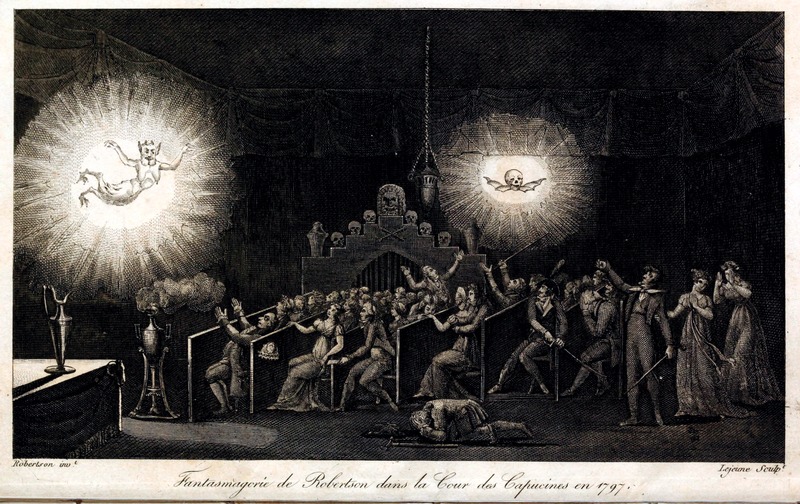
Wikimedia Commons
A phantasmagoria is a ghost show of a type developed by the impresario Paul de Philipsthal, also known as Philidor, a development of the earlier magic lantern shows. Philipsthal began producing ghost shows in 1789, and although he had perhaps sometimes attempted to give the impression that he really was conjuring up the spirits of the dead,[b]In an advertisement published on 14 March 1793 Philidor says “People wishing to see particular representations are asked to give notice the day before: they can then ask for the apparition of any deceased or absent person of their acquaintance that they care to name”, which gave him time to have a slide painted with the appropriate image.[1] by the time of his first show in London in 1801 he was quite open about the fictional nature of the show.[2] The term phantasmagoria is derived from Greek, and means collection of phantasms.[3]
Some of the innovative techniques developed by the early pioneers of the ghost shows, such as back projection, later made their way into mainstream cinema.
Early performances
From December 1792 to July 1793 Philipsthal presented his Phantasmagorie in Paris, and it seems likely that the inventor and impresario Etienne-Gaspard Robert, known as Robertson, visited one of those shows.[4] In any event, Robertson borrowed heavily from Philipsthal’s ideas to become the most famous and skilful projectionist of his day following the opening of his own Fantasmagoria in Paris in 1798.[1]
Typical spectacle
The show would usually take place in darkness. A typical phantasmagoria might start with dazzling flashes of thunder and lightning:
Key technical elements
The early magic lanterns used candles as a source of light to project images painted on glass plates onto a screen, but the much brighter Argand lamp, patented in 1783–1784,[c]The Argand lamp, invented by Aimé Argand, was the first technically efficient oil lamp.[5] allowed the pictures to be displayed for a larger audience.[6] Other developments that enabled the phantasmagoria were the movable lantern, back projection, and the animated slide.[1] Robertson also made use of the glass harmonica attributed to Benjamin Franklin for his eerie musical accompaniments.[7]
A patent Roberston filed in 1799 gives details of his projector, which he called a fantascopeOptical toy producing the illusion of moving images, popular during the Victorian era.. It was 1.6 m high, 95 cm long and 80 cm wide, made of walnut. The body stood on four legs running on two copper rails fastened to the floor. Lenses were mounted in cassettes that allowed them to be easily replaced and to slide up and down the optical tube. One lens was controlled by a rack and pinion mechanism, moving it back and forwards so that the focus could be adjusted as the fantascope moved on its rails. A copper plate at the end of the optical tube acted as a diaphragm, allowing the intensity of the light to be varied.[1]
Images were painted onto glass slides, with a black background, and projected onto the back of a translucent screen made of waxed gauze or muslim,[8] or even onto smoke.[1] Screens were only lowered into place once the show had begun, so the audience was unaware of them; the noise of the operation could be masked by the introductory sound effects. Images could be made to look as if they were advancing or receding by wheeling the lantern backwards or forwards along its tracks. The impression of movement could be conveyed by superimposing slides one over the other.[8]
Legacy
Although an essentially live form of entertainment, many of the techniques used in the production of phantasmagorias anticipated the camera movements of 20th-century film makers: the zoom, dissolve, tracking shot and superimposition.[9]
Notes
| a | The Cour des Capucines was an abandoned Gothic convent that Robertson rented for his shows. |
|---|---|
| b | In an advertisement published on 14 March 1793 Philidor says “People wishing to see particular representations are asked to give notice the day before: they can then ask for the apparition of any deceased or absent person of their acquaintance that they care to name”, which gave him time to have a slide painted with the appropriate image.[1] |
| c | The Argand lamp, invented by Aimé Argand, was the first technically efficient oil lamp.[5] |
